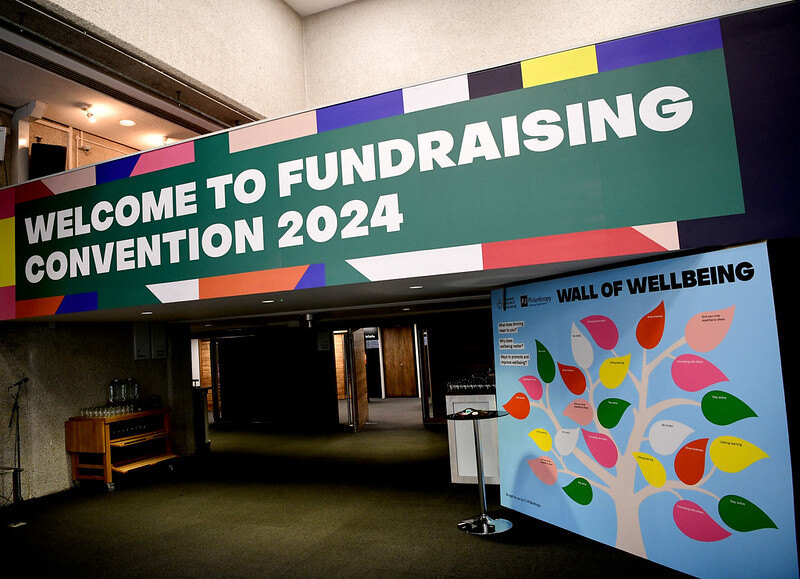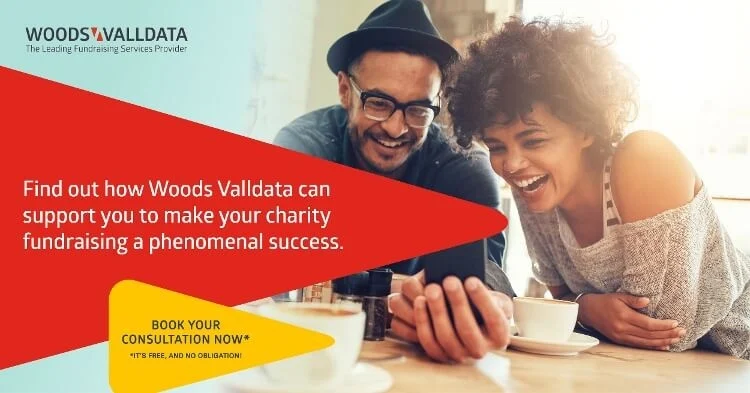
Helen Halahan's summary of CIOF Convention 2024
Highlights from the Chartered Institute of Fundraising Convention 2024
The Chartered Institute of Fundraising (CIOF) Convention 2024 was another bumper event, jam-packed with exceptional content from our exceptional sector. This flagship industry conference once again proved to be a valuable addition to the fundraising calendar, offering endless opportunities to chat, network, and learn. The dedicated volunteer and staff teams ensured everything ran smoothly, and it was wonderful to see new faces and reconnect with old friends.


Here’s a detailed summary of the sessions I attended and my key takeaways from the event.
Demystifying DIY Fundraisers
In the Public Fundraising and Mass Engagement Track Room (sponsored by Woods Valldata), JustGiving and Young Lives vs Cancer provided valuable insights into the rise of DIY fundraising. Here’s what I learned:

-
Rise in DIY Fundraising: Pages created on JustGiving have increased significantly, reflecting a shift towards online fundraising. This trend indicates a growing preference for personalised, self-initiated fundraising efforts.
-
Motivation for Fundraising: Personal connection to the cause remains a strong driver. The biggest reason for fundraising (54%) was because they or their family or friends had been impacted by the issue the charity works towards. This emotional connection is a powerful motivator.
-
Effective Communication: For charity's for whom an individual is fundraising, it is key to provide tools, guidance, and post-event thanks. Most DIY fundraising supporters feel that the level of contact from the charity is just right (84%) but there’s still room for improvement in communication strategies.
-
Gen Z Trends: Gen Z are more likely to fundraise as a group and give one-off donations. Millennials prefer lotteries (I was interested to hear this coming from Just Giving's research!), while Boomers favour regular gifts. Understanding these generational preferences can help charities tailor their fundraising approaches.
-
GDPR Preferences: Preferences are important to obtain at the start of the journey wherever possible, so the supporter's journey can be continued across the charity over time. Ensuring compliance with data protection regulations while maintaining effective communication is crucial.
-
Follow-Up Communication: Ongoing communications can include nice touches to show you’re thinking about your supporters, such as acknowledging anniversaries, not just immediately around the event. Personalised follow-up messages can strengthen supporter relationships and encourage future engagement.
Thank you to Suzy Edington and Elena Green for this informative session.
Is This What the New Normal Feels Like? Insights, data, and benchmarking from leading mass participation teams
A panel from Diabetes UK, Shelter, Prostate Cancer UK, and Mind, chaired by Massive Ltd, discussed the post-pandemic fundraising landscape and how charities can adapt to the new normal. Here are some key points from the discussion:

-
Data and Benchmarks: Essential for evaluating and improving performance. Accurate data helps charities understand where they stand and identify areas for improvement. But they're not easy to obtain which is where the Fundraising Monitor comes in, for charities involved in sharing their data to compare themselves against a wider benchmark.
-
Non-Financial Metrics: Non-financial metrics are also important for showing the broader impact and growing trust. Beyond financial ROI, metrics like supporter engagement, brand recognition, and social impact can provide a fuller picture of a charity’s success.
-
Cross-Organisational Value: Events should be measured for their overall impact, not just immediate ROI. This includes considering secondary actions and long-term benefits of supporter engagement through events.
-
Emerging Opportunities: Streaming, gaming, and content creators offer new fundraising avenues. Leveraging these platforms can attract younger audiences and diversify fundraising channels (NB I also attended a fascinating session from Jingle Jam which focused just on this area. Jingle Jam are worth take a look at if this is something you'd like to find out more about...).
The panel stressed the importance of sharing metrics across the sector to establish benchmarks and improve collective performance. They also highlighted the need to invest in the right events and channels, focusing on those that deliver the biggest impact now and in the future.
Thank you to John Tasker, Hannah Victor, Alysia McDonagh, Seren Evans, and Ian O'Reilly for their insights.
Jen Shang: Learning to Speak About Love in Fundraising
Jen Shang from the Institute of Sustainable Philanthropy provided a fascinating session on the role of love in fundraising. This plenary was one I was particularly looking forward to as Jen has been leading the march on supporter experience and how love plays such an important role in fundraising for years. Here’s a deeper look into the types of love she discussed in this session and their relevance to fundraising:

-
Compassionate Love: This involves extending help to people we don't know and may never meet, such as supporting those suffering in distant countries like Yemen. This type of love is about a broader, humanitarian concern that transcends personal connections.
-
Companionate Love: This type of love is directed towards those with whom we share similar experiences, such as supporting local families in need during the winter. It’s about fostering a sense of community and solidarity with those facing similar challenges.
-
Metanoial Love: This love is about fulfilling moral ideals and transforming relationships. It’s neither purely compassionate nor companionate but involves a deeper, transformative connection. For example, it could be about nurturing a long-term volunteer relationship that significantly impacts both the volunteer and the beneficiaries.
Jen’s insights on the language of love in fundraising offer a unique perspective on how charities can build stronger, more meaningful relationships with their supporters. A full report will be available soon.
Honey, I Shrunk the Database! How to maintain a thriving database and avoid the feeling that it's shrinking after each selection

This session from Woods Valldata, Sequoia Insights and Macmillan in the Public Fundraising and Mass Engagement track highlighted key reasons for shrinking databases, including the effect the media coverage following the Olive Cook inquiry had on fundraising practices, GDPR compliance, COVID-19 impacts, and the cost-of-living crisis.
To address database issues, the panel suggested several steps:
-
Identify Recruitment and Attrition Trends: Determine whether the problem is with acquiring new supporters or retaining existing ones. This initial analysis helps pinpoint where to focus efforts.
-
Analyse Driving Factors: Look into acquisition changes, product reduction, GDPR permissions, and response rates. Understanding the underlying causes of database shrinkage is crucial for developing effective strategies.
-
Mitigate Impacts: Adjust messages, target the right people, and ensure the right ask is made. Tailoring communications to the specific needs and preferences of different supporter segments can improve retention and engagement.
-
Use Segmentation and Modelling: Optimise approaches based on supporter data. By segmenting supporters and using predictive models, charities can personalise their engagement strategies to maximise impact.
Even though databases appear to be shrinking, something can be done. Applying models and approaches, alongside a change is viewpoint away from being solely about ROI and looking at supporter experience in the longer terms can make a huge ongoing impact.
Hannah Mason, Helen Daw, and Jon Kelly provided excellent insights on this topic, highlighting the importance of continuous data analysis and strategic adjustments to maintain a healthy supporter database.
Beyond the Selfie: Unveiling Philanthropic Trends Among Gen Z and Millennial Donors
Thank you to Olumide Akerewusi from AgentsC Inc., Vanessa Babouram from PayPal Giving Fund, Mia Fraser from Amnesty International, and Sujit Peris from Amnesty International for this insightful session. Here’s what I learned:

-
Demographic Importance: Millennials and Gen Z represent one-third of the UK population, but there are six times more charity donors aged 50+ than Gen Z donors. This disparity underscores the need to balance fundraising efforts between engaging younger and older donors without alienating either group.
-
Values-Driven Giving: Gen Z and Millennials are highly values-driven. They discern right from wrong and are more likely to act against injustices. This cultural shift from older demographics means charities must align their messaging with these values to resonate with younger audiences.
-
Diverse Forms of Giving: Financial donations are popular among younger generations, but their concept of giving also includes volunteering, physical gifts, or giving blood. Volunteering, for instance, offers personal benefits like experiences and a sense of community. Charities should therefore promote diverse giving opportunities to engage younger supporters effectively.
-
Transparency is Key: Younger donors demand transparency. They want to know exactly what you're doing in clear terms without any spin. Honest and straightforward communication can build trust and encourage ongoing support.
-
Importance of Stewardship: Gen Z and Millennials seek meaningful engagement with the causes they support. They want to be involved beyond just donating money. Effective stewardship involves keeping these donors informed and involved in the charity’s activities and progress.
-
Predominance of Online Donations: Donations are predominantly online among younger generations. Ease of access, security, no fees, information about the cause, and multiple payment options are critical factors for online giving. Charities should streamline their online donation processes to make it as convenient as possible.
-
Fragmented Giving Channels: Despite the prominence of digital channels, offline methods directing to online resources can be effective to avoid overwhelming donors with online content. Focusing on the most important channels, such as GoFundMe, Instagram, Facebook, and TikTok, can enhance engagement.
-
Leadership Opportunities: Younger donors don’t just want to be donors; they want to be involved in leadership roles within the charity. If not provided opportunities, they might start their own charities. Charities should therefore create pathways for young supporters to take on leadership roles.
-
Innovative Engagement Strategies: There’s a need for the sector to think differently. Engaging families, focusing on what matters to younger people, and exploring alternative methods of giving, such as cryptocurrency, can attract and retain younger donors.
For more insights, you can download the report from thefutureofgiving.ca.
Contact Us
The CIOF Fundraising Convention 2024 highlighted the evolving landscape of individual giving. Our sector is dynamic, engaged, and full of opportunities. If you’re looking to optimise your fundraising strategies, explore new ways to fundraise, deliver better supporter experiences or need support with response handling services, contact us today to discuss how we can assist you. Let's work together to elevate your ability to achieve more.
Categories
- charity fundraising (50)
- Lottery (40)
- Income Generation for Charities (38)
- Raffle (37)
- Appeal response handling (31)
- Response Handling (27)
- fundraising insights (23)
- charity gaming (19)
- charity raffle (17)
- Fulfilment (16)
- charity insights (16)
- Compliance (12)
- Company News (11)
- benchmarks (10)
- Direct Debit (9)
- Services (8)
- creating a fundraising strategy (8)
- Gambling Act (5)
Archives
- March 2020 (5)
- May 2022 (4)
- October 2022 (4)
- January 2023 (4)
- June 2023 (4)
- May 2024 (4)
- June 2024 (4)
- March 2021 (3)
- April 2021 (3)
- July 2023 (3)
- August 2023 (3)
- April 2024 (3)
- July 2024 (3)
- November 2025 (3)
- June 2020 (2)
- August 2020 (2)
- October 2020 (2)
- November 2020 (2)
- November 2021 (2)
- January 2022 (2)
- February 2022 (2)
- February 2023 (2)
- March 2023 (2)
- September 2023 (2)
- December 2023 (2)
- February 2024 (2)
- March 2024 (2)
- February 2025 (2)
- July 2025 (2)
- December 2025 (2)
- June 2015 (1)
- November 2017 (1)
- February 2020 (1)
- April 2020 (1)
- May 2020 (1)
- July 2020 (1)
- September 2020 (1)
- May 2021 (1)
- June 2021 (1)
- August 2021 (1)
- September 2021 (1)
- October 2021 (1)
- December 2021 (1)
- March 2022 (1)
- April 2022 (1)
- June 2022 (1)
- July 2022 (1)
- August 2022 (1)
- September 2022 (1)
- December 2022 (1)
- May 2023 (1)
- October 2023 (1)
- November 2023 (1)
- January 2024 (1)
- September 2024 (1)
- January 2025 (1)
- March 2025 (1)
- September 2025 (1)
- October 2025 (1)
